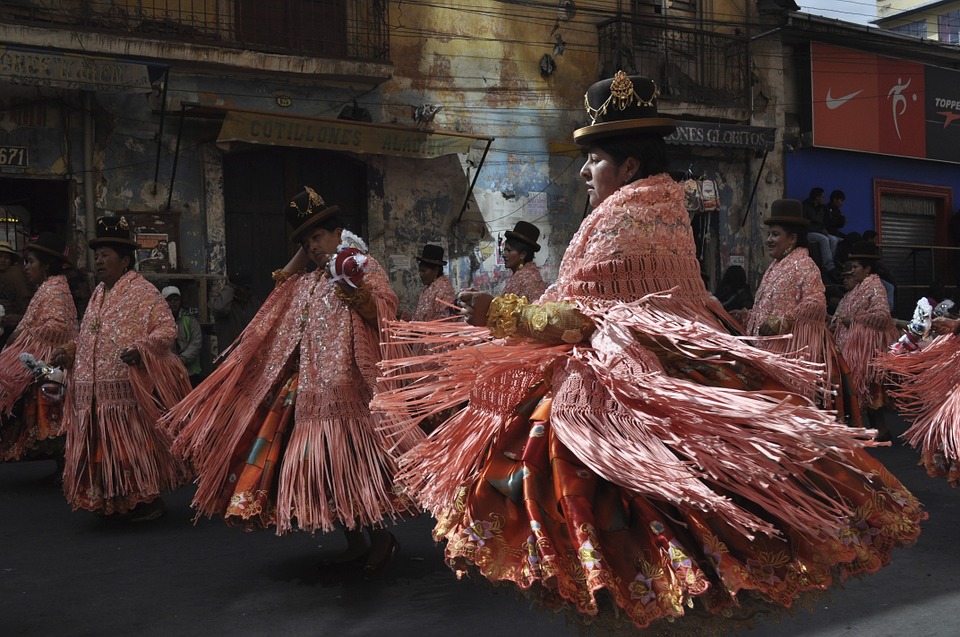In today’s article, we continue our discovery on Bolivia and its fabulous culture and traditions. If you’ve haven’t check the first part of our blog yet, you can do so here. Enjoy! Clothing Typical Bolivian
In today’s article, we continue our discovery on Bolivia and its fabulous culture and traditions. If you’ve haven’t check the first part of our blog yet, you can do so here. Enjoy!
Clothing
Typical Bolivian clothing is characterized by dresses made of alpaca, vicuña and sheep wool, painted with natural dyes and with geometric, sometimes zoomorphic and anthropomorphic designs. Another type of costume is observed in the departments of Santa Cruz, Beni and Pando, where a long one-piece dress with short sleeves is usually worn. However, the dress may have some variations depending on the region.
On the other hand, the dress of the Guaraní culture in Bolivia is different for men and women. In this sense, men wear tunics made from the bark of a tree called bibosi, while women wear the tipoy, a long dress with slits on the sides.
Bolivia’s Gastronomic Culture
The Tiwanaku civilisation played a key role in the development of Bolivia’s gastronomic culture, as it began to cultivate the land and incorporated the use of ingredients that are still used today. For its part, Bolivian cuisine makes abundant use of tubers such as potatoes, yucca, oca, yacon, achira and racacha in its preparations. In addition, a lot of corn is consumed.
By region, there are also different preparations that reflect the different types of cultivation in Bolivia. In the Andean region, preparations such as spicy assortment, plato paceño, sajta de pollo, aji de papalisa, humacha cheese are usually eaten. Among the valluno dishes are peanut soup, trancapecho, ranga, chancho a la cruz, k’awi and rabbit lambreado. Recommended oriental dishes include locro, majadito, masaco and patasca.
Bolivian Society
Bolivian society tends to be hardworking, receptive to foreigners, hospitable, generous and informal. They are also very family-oriented. The lifestyle, on the other hand, is very much determined by the economic situation, in fact there are many innocent jokes about the social inequality of the country. Nevertheless, many Bolivians have a simple life where formal and informal work is the main activity.
Alasita Fair

Around the 24th of January in the city of La Paz one of the most important festivities of Bolivian culture is celebrated, the Alasita fair. Its origins date back to the pre-Hispanic period of the Pucara and Tiahuanaco cultures in the Bolivian Altiplano and was eventually adopted by the Aymara.
It consists of a fair where people buy all sorts of miniatures to offer to Ekeko, the Aymara god of abundance, in the hope that he will bring them good fortune throughout the year. The etymology of the Alasita fair comes from the Aymara word “alasitha”, which means “to buy”.
Every year, this fair brings together about 5,000 artisans. Among the miniatures you will find tiny banknotes, copies of newspapers, houses, cars, roosters, chickens and even building materials. On the other hand, there are visits with a deep spiritual meaning, so much so that these rituals in the city of La Paz during the Alasita, were declared intangible heritage of humanity by UNESCO in 2017.
Festival of the Great Power
Also known as Fiesta de Jesús del Gran Poder, Fiesta de la Santísima Trinidad del Señor Jesús del Gran Poder or Festividad del Señor del Gran Poder is a religious celebration that brings together approximately 25,000 local participants. This celebration is a mixture of Catholics and Aymaras. There are activities such as ch’alla, folkloric entries, celebration of Catholic masses and the development of prestes.
Another aspect that stands out is that it highlights the value of being Andean. This festival has a remarkable community value. In this respect, for the transformation and stimulation it gives to the city each year as a special way of understanding and celebrating Andean Catholicism, UNESCO has declared the Great Power Festival as Intangible Cultural Heritage of Humanity in 2019.
What do you think about the culture of Bolivia so far? Interested in learning even more traditions? Come back to check out the third part of our article. Until then, tell us when have you planned to visit Bolivia? Leave a comment below!


One thought on “Let’s Learn More about the Rich Cultural Diversity of Bolivia (Part Two)”